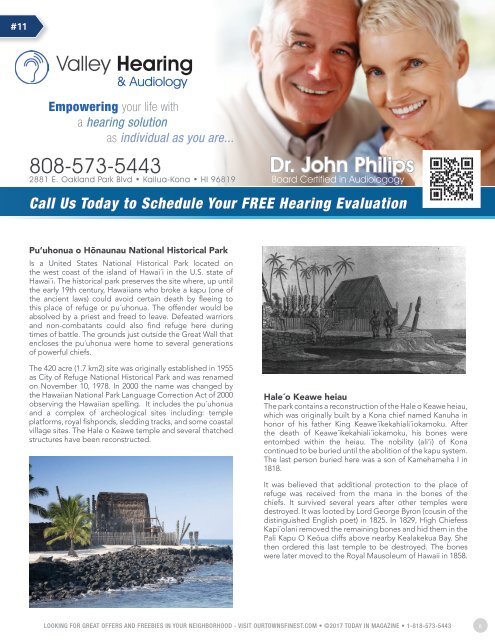TODAY-IN-KONA-SAMPLE-BOOK
TODAY-IN-KONA-SAMPLE-BOOK
TODAY-IN-KONA-SAMPLE-BOOK
You also want an ePaper? Increase the reach of your titles
YUMPU automatically turns print PDFs into web optimized ePapers that Google loves.
#11<br />
Valley Hearing<br />
& Audiology<br />
Empowering your life with<br />
a hearing solution<br />
as individual as you are...<br />
808-573-5443<br />
2881 E. Oakland Park Blvd • Kailua-Kona • HI 96819<br />
Dr. John Philips<br />
Board Certified in Audiologogy<br />
Call Us Today to Schedule Your FREE Hearing Evaluation<br />
Puʻuhonua o Hōnaunau National Historical Park<br />
Is a United States National Historical Park located on<br />
the west coast of the island of Hawai´i in the U.S. state of<br />
Hawai´i. The historical park preserves the site where, up until<br />
the early 19th century, Hawaiians who broke a kapu (one of<br />
the ancient laws) could avoid certain death by fleeing to<br />
this place of refuge or pu´uhonua. The offender would be<br />
absolved by a priest and freed to leave. Defeated warriors<br />
and non-combatants could also find refuge here during<br />
times of battle. The grounds just outside the Great Wall that<br />
encloses the pu´uhonua were home to several generations<br />
of powerful chiefs.<br />
The 420 acre (1.7 km2) site was originally established in 1955<br />
as City of Refuge National Historical Park and was renamed<br />
on November 10, 1978. In 2000 the name was changed by<br />
the Hawaiian National Park Language Correction Act of 2000<br />
observing the Hawaiian spelling. It includes the pu´uhonua<br />
and a complex of archeological sites including: temple<br />
platforms, royal fishponds, sledding tracks, and some coastal<br />
village sites. The Hale o Keawe temple and several thatched<br />
structures have been reconstructed.<br />
Hale´o Keawe heiau<br />
The park contains a reconstruction of the Hale o Keawe heiau,<br />
which was originally built by a Kona chief named Kanuha in<br />
honor of his father King Keawe´īkekahiali´iokamoku. After<br />
the death of Keawe´īkekahiali´iokamoku, his bones were<br />
entombed within the heiau. The nobility (ali’i) of Kona<br />
continued to be buried until the abolition of the kapu system.<br />
The last person buried here was a son of Kamehameha I in<br />
1818.<br />
It was believed that additional protection to the place of<br />
refuge was received from the mana in the bones of the<br />
chiefs. It survived several years after other temples were<br />
destroyed. It was looted by Lord George Byron (cousin of the<br />
distinguished English poet) in 1825. In 1829, High Chiefess<br />
Kapi´olani removed the remaining bones and hid them in the<br />
Pali Kapu O Keōua cliffs above nearby Kealakekua Bay. She<br />
then ordered this last temple to be destroyed. The bones<br />
were later moved to the Royal Mausoleum of Hawaii in 1858.<br />
LOOK<strong>IN</strong>G FOR GREAT OFFERS AND FREEBIES <strong>IN</strong> YOUR NEIGHBORHOOD - VISIT OURTOWNSF<strong>IN</strong>EST.COM • ©2017 <strong>TODAY</strong> <strong>IN</strong> MAGAZ<strong>IN</strong>E • 1-818-573-5443<br />
8

















